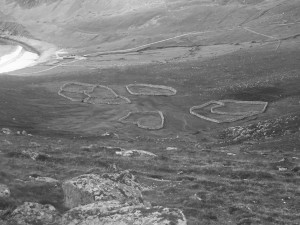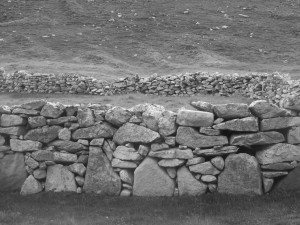 The Jackdaw was given exclusive advance access to a grand project which seems certain to become a place of pilgrimage for intrepid devotees of Land Art. Dixon Smith reports.
The Jackdaw was given exclusive advance access to a grand project which seems certain to become a place of pilgrimage for intrepid devotees of Land Art. Dixon Smith reports.
Already being hailed by the few allowed to see it as the masterpiece of Land Art in the British Isles, In Transit has been one of public art’s best kept secrets. The Jackdaw was given an advanced sighting before the official unveiling later in the autumn – the work’s location and the identity of the artist are strict secrets until the piece is unveiled to the press. We can reveal however that it is in an extremity of Scotland so remote only the most energetic and intrepid of art anoraks will find it: and it is not a disappointment. The name of the artist should not defeat most art aficionados: he is well-known for the solitary remoteness of his previous exploits.
The site was offered as private land, and therefore not subject to complicated and delaying planning permission. When first approached four years ago, the artist responded enthusiastically to the genius loci, its natural deserted beauty and exposure to the unpredictable Atlantic climate. For the construction he was assisted by a team of artisans, and adopted a looser, more rustic style of dry stone wall-building than the sterile precision more typical of his oeuvre: he used available hillside material as quarry and for authenticity. The work’s title refers to the transient occupation of land and the maker’s insistence that the work should weather and settle, even collapse, naturally in the future, eventually to disappear. It was important to him that the finished piece should echo the work of farmers to cause ambivalence in the mind of those encountering it. The precise shape and spacing of the rough rectangles, their subdividing into writhing shapes, evolved gradually. Decisive planning informed the apparent randomness. Crucial in the calculations is that the eventual accidental discoverers of the work might be ambiguous to the significance of what they see; for example, is it art or nature, decorative or functional? Is it the work of a peasant or of an artist?
 No other land artist has worked before on such an epic scale, nor with such freedom and so grand a simplicity of effect. This is seen to best impact from flanking mountainsides which viewers must negotiate gingerly to approach closer. The underlying concept was to echo the original use of the land as a place for farming hill sheep but to add the artist’s twist of making the result less geometric and therefore less obviously functional to the eye.
No other land artist has worked before on such an epic scale, nor with such freedom and so grand a simplicity of effect. This is seen to best impact from flanking mountainsides which viewers must negotiate gingerly to approach closer. The underlying concept was to echo the original use of the land as a place for farming hill sheep but to add the artist’s twist of making the result less geometric and therefore less obviously functional to the eye.
“The asymmetry is its most inventive aspect,” remarked project curator Phil Muir. “It challenges the viewer to work out the artist’s performative purpose and practice. The shapes of the folds are taken straight from the biology microscope and are demonstrative of the microcosm becoming macro. These gateless enclosures threaten to divide like cells and then spread.” There is no doubt that first seeing the piece as you approach along a precipitous ridge, they seem more to do with abstract art than the graft of shepherding and winter shelter for the flock.
“This is a historic place,” says Muir, “with evidence of occupation since at least the Bronze Age. Life here was tough, the hardship unimaginable today, and the eventual clearances cruel. It has been completely abandoned for a century, and the artist was attracted to this opportunity precisely because he was able to reflect the former function of this place while introducing art to a location in which it is unfamiliar. We are hoping people will encounter it by accident and be inspired to ponder its enigmas. We want it to form a lyrical, uplifting contrast to what is barren, unforgiving land.”
The Jackdaw, August 2012
